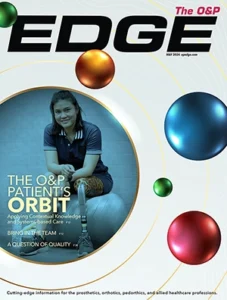Many years ago, I injured my ankle and bones through the fifth metatarsal. Since I was young and stubborn and the dance world often took a much less enlightened approach to injury healing than it does today, I certainly did not follow adequate rehabilitation protocol. After seeing a sports medicine specialist on campus, I iced it that night and resumed my normal dance schedule of four to six hours per day in the studio within a day or two. Fast forward to my present reality and several ankle sprains within the past five years, I can attest to the truth that previous injury predisposes patients to reinjury. So I appreciate the preventive measures pedorthists and lower-limb orthotists can provide as individuals endeavor to remain active or regain their mobility—and I’ve learned to stay out of the studio until a sprain is healed.
One obstacle that has presented itself since last year is the absence of a pathway for aspiring pedorthists to enter the profession. Since the last institution offering pedorthic education discontinued its program, the National Commission on Orthotic and Prosthetic Education (NCOPE) put the accrediting process for programs on hold. As a result, there has not been a pathway for new pedorthists to enter the profession, leaving a gap between the number of pedorthists and patient need. In the wake of NCOPE’s decision, the American Board for Certification in Orthotics, Prosthetics & Pedorthics stepped in and approved new standards for precertification courses this summer. Pedorthic professionals shared their perspectives about how this development will impact growth and professionalism in the field in “Pedorthists Optimistic About Renewed Educational Pathway to Certification.”
Support authors and subscribe to content
This is premium stuff. Subscribe to read the entire article.





